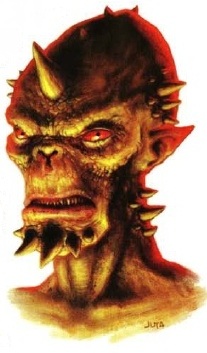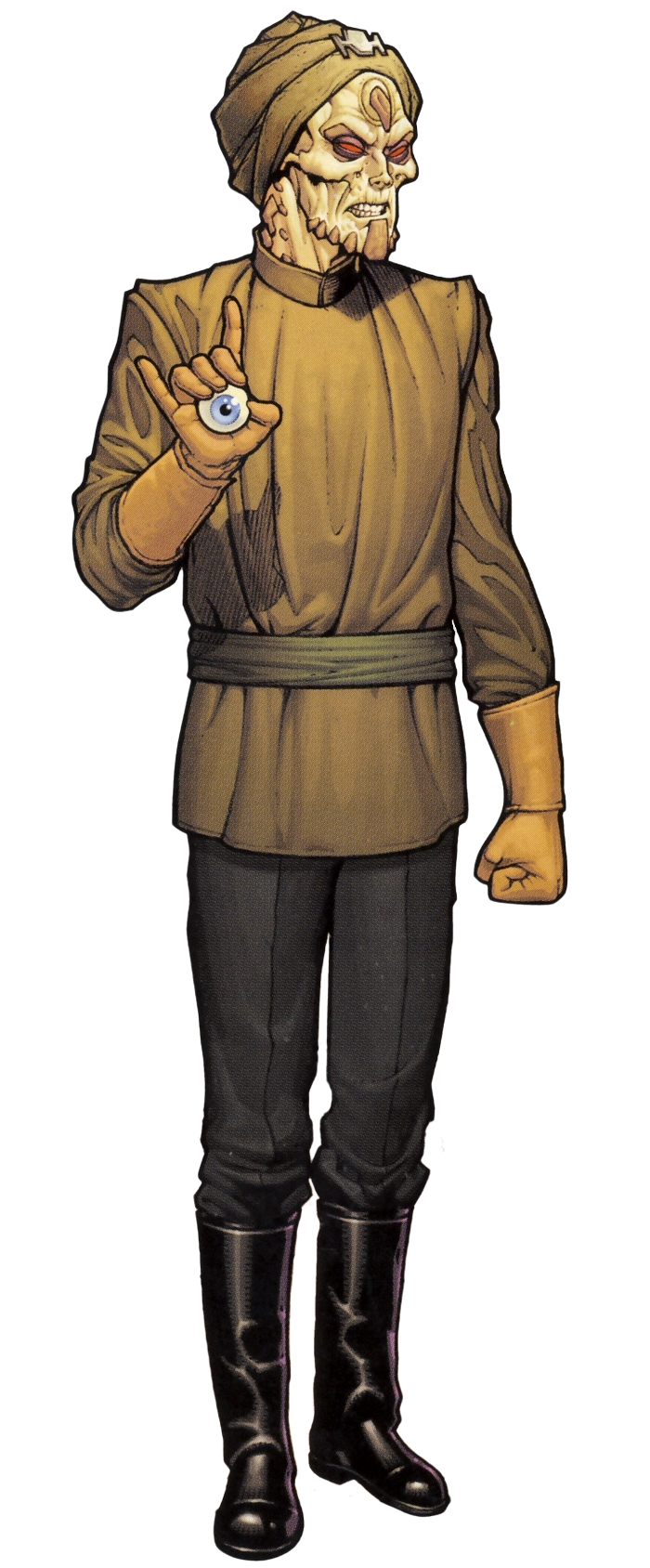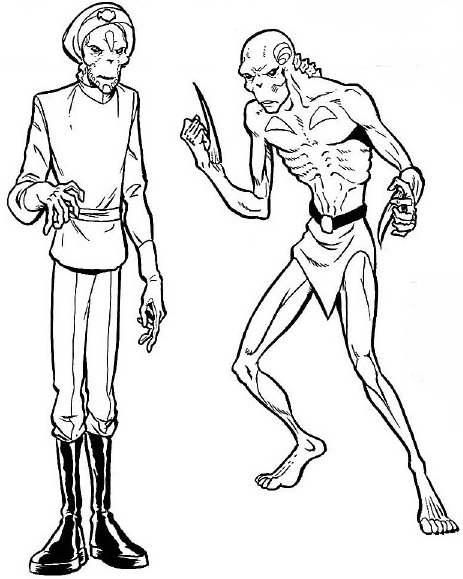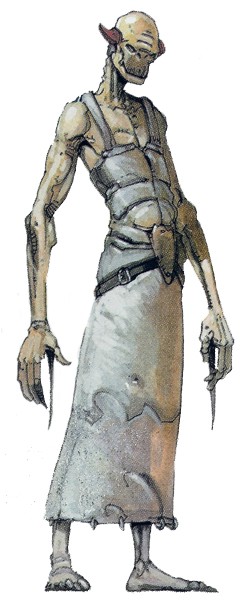The Yevetha (pronounced /jɛ'vəθə/) were a lithe, skeletal species indigenous to N'zoth in the Koornacht Cluster in the Core Worlds, known for their xenophobia and death-centered culture.

A male and female Yevetha
Physically, the Yevetha were tall beings that stood on average up to 1.9 meters in height with light gray skin and a ghoulish appearance that was bereft of any body hair. Male and female members of the species were roughly the same height and build with adults standing between 1.5 to 2.5 meters. They were noted as being a mammalian species with a thin, bony humanoid form. They were described as being so gaunt as to seem skeletal due to their pallid gray skin and lithe builds. Their alien physiognomy was noted for being close enough to a humanoid to the point that it was possible to determine their body language due to the similarities. These tall gaunt humanoids had wide set and large black gray eyes. Their black eyes were said to be as expressionless as stones. The backs and necks were both scaled, which was an evolutionary vestige of natural body armor once possessed by the race. Thus, their skin incorporated this vestigial form of armor that went down from their backs to their necks and down their spines.
Amongst the males of the species, there were scarlet facials crests that ran along cheeks, jaws and the tops of their heads. This larger crest ran across the top and down the back of their heads. A male's facial crests swelled when they were spurred to violenceor combat. The primary head crest became engorged when a male was ready to mate. Female members of the species did not exhibit such features. Yevetha brains were located in their thoraxes where they were protected by thick bone that served as brain cages. They also possessed fine hair cells that ran as indentations along their temples which provided auditory senses. The race possessed six fingered hands that had retractable dew claws. Each one was located on the inside of the wrist above their six-fingered hands. Their dewclaws shot from a sheath of a skin from their cadaverous hands and were capable of being retracted. When extended fully, the wrist blades were equal to the length of a vibroblade. These blades extended to about a foot in length, and were used in close combat and blood sacrifices. The Yevetha also appeared to possess a greater tolerance for g-forces when compared to Human pilots.

Closeup of Yevethan facial features.
Young Yevetha were born when the females reproduced by laying eggs that were known as "birth casks". The detachable external birth casks were known to the Yevetha as a mara-nas. These were external wombs that were placed in special chambers and the unborn child was fed blood that was absorbed through the shell of the eggs. Should the child remain within the cask past birth then they were referred to as "nestings". Normally, unborn children were fed a diet of blood that was preferably from the mother. However, the blood of any Yevetha was capable of nourishing the young, and the species' biological need for blood became an important factor that shaped their society. In rare cases, birth casks were capable of giving birth to twins that were generally identical except for their age.
Yevetha were known to suffer from a disease called gray death, though the symptoms remain unknown. Additionally, despite it being extremely rare, some Yevetha were born genderless. These genetic "curiosities" were born white and pale in appearance, with apparently no sexual organs visible or present. Although unsubstantiated, some in the New Republic speculated about a possible relation between the Yevetha and Twi'leks.
Upon their birth, a Yevethan newborn entered the world and was considered a "child" for about the first five years of life. Around age six, they began to develop into a subadult, a prepubescent stage lasting until about age 11. An adult was any Yevethan between 12-44 years old, while "middle-aged" individuals were between 45 and 66, and the elderly were 67 years and above; those living beyond 81 years were considered venerable in Yevethan society.

Nil Spaar; Darama of N'zoth.
Yevethan culture was organized into a strict hierarchical system, headed by the Darama. Politically, their society was led by a Viceroy, who also operated as the chief of state for the Duskhan League. The Darama and Viceroy were linked positions, connecting Yevethan spirituality and politics. The departments and fields of governance, commerce, science and culture were all led by Proctors and supported by various guilds. This structure was mirrored in Yevethan armed forces and shipboard staffs, led by Primates. Their technical abilities meant they were quite capable of simply studying mechanical information or manuals briefly, and not only duplicating the technology, but likely improving upon it. Thus their guildsmen were excellent workers, builders, and quite skilled starship designers. This uncanny, natural gift for working with advanced technology was just one more reason for the Yevetha to be arrogantly proud, and to think highly of themselves. Nonetheless, it was widely known that the Yevetha were considered "quick studies" and extremely intelligent.
Within their society, raw blood was a key focus, and was a central aspect of their religion and belief system. This resulted in Yevethans becoming a particularly violent species. For them, death was not to be feared. As a whole, Yevethan were generally described as dutiful and attentive, if not somewhat cautious—and also fatalistic—in their views of the universe. When fighting against their enemies, Yevetha were noted for being ruthless, never surrendering, even in the face of certain defeat, due to a personal honor code. Given the brutal nature of their society, the Yevethans did not operate a single prison, penitentiary or stockade, as they believed there was no need for such "punishments". In fact, their mother tongue, Yevetha, did not feature a word in the vocabulary for "convict", nor for "incarcerate".

A pair of Yevethans.
The Yevetha society was a highly stratified one, made up of a number of different castes. Those of lower rank were never able to truly ascend to the higher levels of society, though it was known that a higher-caste individual could be "demoted" to a lower caste, in extreme instances. Despite the lowly status of these "subordinate" castes, the extreme arrogance and xenophobia of their race led Yevethans to believe that simply being Yevetha was a blessing, of any caste, rather than being born a different race. Their prejudice towards all other beings besides themselves gave the lower caste Yevetha a sense of dignity, while aliens and off-worlders were considered little more than galactic vermin. Among other caste-related policies within Yeveth society were dominance killings, similar to "honor" killings, where a charge of murder was only to be brought against a lower-caste Yevethan taking the life of a higher-ranking individual . The killing of a low-ranking Yevetha was considered perfectly acceptable by the higher castes, as it was one less mouth to feed and one less nuisance in society. This strict caste system dominated Yevethan life, meaning that young Yevetha grew up with the knowledge that at any moment, a superior was justified in taking their lives from them, simply for blood.
Sacrifice, particularly to provide blood for a birth cask of an important Yevetha, was considered honorable to the family of the sacrificed individual. Birth casks were often placed in "breederies", which were considered private locations. On certain occasions, a Yevetha was known to meet with visitors outside. To support a high-ranking Yevetha, there was typically a breeding-assistant who administered the arrival of sacrificial Yevetha for the birthing casks in order to feed them. The Yevetha considered twins to be auspicious, and it was believed that, in their tradition, such offspring passed on their "blessings" to those around them by simply breathing, touching, and even bleeding. It was common for nitakka (Yevetha males) to spar, embedding young Yevetha with a unique set of fighting instincts: "the closest threat is the greatest threat—in a fight of unequal numbers, dispatch your weakest opponent first to discourage others from joining a fight against you, charge a newcomer immediately—hold nothing back when you go to kill." These instincts were difficult to suppress, producing erratic battlefield results for inexperienced military crews.
While the lower classes were treated with nothing but contempt, the reaction of the race to other non-Yevetha was even more severe. The Yevetha were considered one of the most xenophobic and bigoted species within the galaxy. In fact, they considered non-Yevetha to be little more than vermin. As a result, the Yevetha tended to consider other species to be hardly worth their attention. This was partly attributed to the relative youth of their homeworld and its location where stars of the greater galaxy were masked with the brightness of the Koornacht Cluster. As a result, the Yevetha originally believed themselves to be the only intelligent beings in existence. Following contact and their initial enslavement, this attitude was only slightly altered as the race now believed that they were the only worthy species in existence and that all other races were to be exterminated. This xenophobia extended to such a level that they refused to learn alien languages such as Basic, as they found it being repulsive. In order to communicate with "vermin", many high-ranking Yevetha made those of the lower castes learn the language in order to serve as translators. While this was the case, there were certain cadres of high-ranking Yevetha that deigned to learn alien languages as they believed there were certain things not meant to be heard by the subordinate castes.
This conceited belief in their status as being the only intelligent life in existence stemmed from even ancient times on their homeworld. In fact, it was known that not even a single member of their greatest thinkers had even considered the concept of there being the presence of other forms of sentient life on other worlds. Ultimately, it was held that while they had rapidly advanced on a technological basis, their culture was still in an adolescent stage of development.

N'zoth, the Yevetha homeworld
A relatively young species, the ancient Yevethans had only evolved on their home planet of N'zoth around 50,000 years ago. Since that time, they had quickly advanced on their homeworld and in isolation to any other form of sentient life. The position of their planet meant that the race never knew there were other stars in the galaxy. This along with a combination of their rapid evolution, isolation and harsh environment produced a culture that was highly xenophobic. This also established an internal concept of superiority. In fact, the Yevetha believed themselves to had been the only intelligent species in existence. Eventually, their race perfected space travel and their expansion into space led them to colonize eleven other nearby worlds. This came shortly after they had developed a planetary wide governing hierarchical system. This in turn led to the establishment of the Yevethan Protectorate that consisted of the original daughter worlds settled by real space ships that operated without hyperdrive and became collectively known as "The Twelve". On such worlds, the Yevetha only encountered animal forms of life which preserved their concept of being the only intelligent species in the universe.
At this point in their history, the species was well within the information age and at the cusp of the space age on a technological level. Despite maintaining their isolation, at least a single Yevetha was present on Coruscant in 18.8 BBY; this individual seemingly managed his xenophobic impulses and played Shronker in the Zi-Kree Sector. Nick Rostu encountered this individual and wound up in a fight with him after the Yevetha lost the game. Over the millennia, the Yevetha continued to live in relative peace, and their beliefs remained unchallenged until the arrival of the Galactic Empire. The Koornacht Cluster was swiftly defeated during the early years of Imperial expansion. Under Emperor Palpatine's reign, the planet N'zoth was seized and made the site of an Imperial shipyard. An Imperial government enslaved the Yevethans and placed them at work in newly constructed shipyards where they served as technical and maintenance personnel. With amazing speed, they mastered shipbuilding and weapons technology. The Yevethans were known to have taken to the technology with astonishing speed and aptitude.
It was duly noted by the Empire that the Yevetha had a rapid ability to learn new skills. After subjugating N'zoth and its nearby star systems, Imperial forces built the Black Fifteen shipyards, and put the Yevetha to work as skilled slave labor for building, repairing, and modifying vessels of the Imperial Starfleet. Despite their enslavement, the Yevetha made nominal attempts at resistance, which led to a number of sabotage attempts at the shipyards. Even with this being the case, the Black Fleet shipyards were noted for their excellence, with the facility's reputation resulting in its prestige as the finest conscript facility within the Empire. The Imperial Governor of the Cluster took several females as pleasure slaves for his staff, and gave the males to his stormtroopers for target practice. The mutilated bodies were then put on display at schools and sacred sites. They were also broadcast on public information channels that all Yevetha were forced to watch twice a day. When subjugation was not working as desired, children were taken from their parents. Initially, the Yevetha decided to submit to Imperial rule and waited until the time came that the Empire became lax in their control.
Around eight months after the Battle of Endor, Ysanne Isard recalled many Star Destroyers to defend the Core Worlds. Amongst the Imperial armadas that received this order was the Black Sword Command; upon receiving the order, the Command prepared to depart the central shipbuilding facilities at N'zoth. Before the Imperial garrison was able to destroy the shipyards, an uprising emerged amongst the Yevethan dockworkers. This prevented the Imperials from initiating the mass killing of the slaves and the destruction of the repair yards. The shocking uprising was led by ground commando Nil Spaar, who moved to counter the mass slave executions. He took advantage of the Empire's view of the Yevetha as a brainwashed, mindless species and seized control of the yards. Spaar murdered thousands of Imperials and hundreds more were captured whilst every Star Destroyer in the Black Fleet was overtaken. When the Imperial garrison finally reached the shipyards they found seven thousand freed Yevethan prisoners, as well as the remains of over fifteen thousand dead Imperial soldiers. Fearing the same fate, the Imperial garrison never returned. Amongst the Yevetha's conquests included the capture of the Super Star Destroyer Intimidator, with the Yevetha covering up the entire incident. This led to the New Republic never hearing of the incident and Isard believing that the fleet was destroyed on Cal-Seti based on inaccurate intelligence. Afterwards, the Koornacht Cluster remained a closed-border curiosity to the rest of the galaxy.
Over the next decade and a half, the Yevetha developed their technical capabilities. They created new starship shielding, gravity bombs, Aramadia-class thrustships, and D-type fighters. They also established the Duskhan League, which grew to encompass thirteen worlds. The Yevethan fleet was dubbed the Black Fleet, in a twisted version of its predecessor, the Galactic Empire Black Sword Command.
In 16 ABY, the Dushkan League came out of isolation and engaged the New Republic. A delegation, led by Viceroy Nil Spaar, arrived at Coruscant to seek a peaceful co-existence. Nil Spaar used the New Republic's lack of intelligence on the Duskhan League as well as their senatorial political conflict to his advantage. Spaar extended his negotiations with Chief of State Leia Organa Solo over a period of weeks and played into her empathy towards a species subjugated by the Empire. This allowed him to cultivate assets on Coruscant, and set off a series of political machinations, sowing confusion amongst the members of the New Republic.

A Yevethan male
Nil Spaar returned to his people and, with the New Republic in disarray, the Yevetha launched a campaign of brutal expansion and colonization. The Yevethan Purge saw the elimination of entire species, such as the Corasgh, and communities like the Norat Sovereignty, and the Yevetha thereafter colonized many nearby star systems in the Koornacht Cluster. In the following weeks, foiled reconnaissance efforts by the New Republic prompted an armed conflict between the Duskhan League, its hidden Black Fleet, and the New Republic Defense Force's new Fifth Battle Group.
The conflict concluded with a Yevethan loss at the Battle of N'zoth as well as the reported death of Nil Spaar at the hands of Imperial officer Sil Sorannan. The victorious New Republic disarmed the Yevetha and kept them under close watch. Active Republic patrols were eventually removed by at least 25 ABY. Following their defeat, the palace of the Viceroy remained as the late Nil Spaar had left it, with many Yevetha fruitlessly holding on to the hope that their leader would return at some point in the future.
Since no being had entered the N'zoth system since the Battle of N'zoth, this allowed the Yevetha to build an even larger force than before. It consisted of more than ten thousand Aramadia-class thrustships. Once the new Yevethan fleet had been built, the Galantos Guard encountered the Yuuzhan Vong. In exchange for what the Fia believed to be protection from the extragalactic invaders, they informed the Yuuzhan Vong of the brutal Yevetha and their eminent threat. Taking heed, the Yuuzhan Vong invaded the N'zoth system. In the subsequent battle, the Yuuzhan Vong emerged victorious. The Yuuzhan Vong proceeded to orbitally bombard N'zoth, rendering the planet a molten wasteland.
The besieged Yevetha continued to refuse outside help, and were eventually rendered nearly extinct. While many believed the species had been destroyed, it was speculated by some that their expansionist tendencies might have resulted in some colonies that escaped the notice of the Yuuzhan Vong. In fact, after the fall of N'zoth, it was estimated that fewer than ten thousand Yevetha were still alive in the galaxy.
- Cracken's Threat Dossier
- Alien Encounters
- The Essential Guide to Planets and Moons
- "Star Wars Episode VII: Rise of the New Republic" — InQuest Gamer 50
- The Essential Guide to Alien Species
- Alien Anthology
- The Official Star Wars Fact File7
- The Official Star Wars Fact File9
- Coruscant and the Core Worlds
- Ultimate Alien Anthology
- The New Essential Guide to Alien Species
- Jedi vs. Sith: The Essential Guide to the Force
- The Complete Star Wars Encyclopedia
- The Essential Atlas
- Galaxy at War